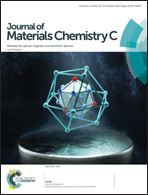Organic phototransistors based on perylene diimide nanocrystals lacking π–π interactions†
Abstract
We report on the fabrication and characterization of organic phototransistors (OPTs) based on fluorescent nanocrystals assembled from a simple organic dye molecule (N,N′-bis(2,4-dimethylpent-3-yl)perylene-3,4:9,10-tetracarboxylic diimide, DMP-PDI). The OPT active layer is based on DMP-PDI nanocrystals assembled in aqueous solution or within polymer films. Despite the absence of any π-overlap, the nanocrystals show mobilities as high as (5 ± 1) × 10−3 cm2 V−1 s−1 in polymer films, which is due to imide/π-core noncovalent interactions leading to substantial electronic coupling as revealed by computational studies. The OPTs strongly respond to white light irradiation, resulting in a decrease in threshold voltage by as much as 40 V. OPTs based on nanocrystals assembled within polymer films have threshold voltages close to 0 V upon illumination and a high photo/dark current ratio (P = 4 × 103). We show that the organic crystals lacking π-overlap mediate charge mobility and are advantageous as active layers for OPTs due to diminished nonradiative decay.



 Please wait while we load your content...
Please wait while we load your content...